How to choose a pump for a well: recommendations for choosing pumping equipment
The operation of a well is impossible without the use of a mandatory component of its arrangement - a pump.After all, a bucket is absolutely not suitable for collecting water from a narrow trunk. In addition, lifting from the depths and transporting water manually would take too much effort and time. I don’t want to waste either one or the other, do you agree?
Properly selected pumping equipment will fill containers in a bathhouse, home, or garden in a matter of minutes. Now it is possible to purchase equipment to service an object of any size. On its basis, you can easily build an automatic water supply system that does not depend on centralized supplies and the participation of owners in the pumping process.
We will tell you in great detail how to choose a pump for a well, what the future owner of the device needs to take into account and provide. A scrupulous explanation of important points for the user is supplemented with photos and video guides.
The content of the article:
Taking into account well characteristics
Before purchasing a suitable pump for a well, you need to clarify a number of indicators of your structure:
- static level;
- dynamic level;
- flow rate;
- bottom base mark;
- pipe diameter.
If drilling a well was carried out by a specialized drilling company, then, in accordance with the contract, the owner should have been provided with its technical passport. All the characteristics mentioned above must be indicated in it. However, in cases where the well is used (or not used) for a long time, it does not hurt to clarify this information.
Owners of wells that were created on their own or with the help of hired “scavengers”, of course, do not have such a document. They will have to study their well on their own and determine its characteristics using simple measurements.
The static level is the distance that separates the permanent water surface from the surface of the earth. To set this distance, you will need a string with a weight tied to it in the shape of a cylinder or cone without a bottom.
You can use a plastic tube instead. You will also need a tape measure or ruler. The length of the string should be comparable to the depth of the well.
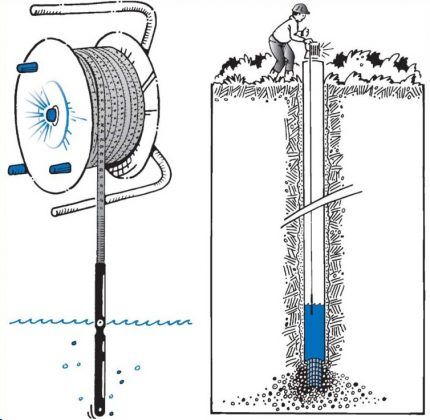
Before starting measurements, you must refrain from drawing water from the well for at least an hour. During this time, the water level should reach its maximum. Now the string with the load is lowered into the well until the load “slaps” on the surface of the water. The characteristic sound is usually clearly audible.
All that remains is to make a mark on the string, remove it from the shaft and measure it with a suitable tool. The first indicator of well characteristics has been determined. The dynamic level is considered to be the distance from the surface of the earth to the minimum water level in the well shaft.
To determine the dynamic level, first the well needs to be prepared. Water is pumped out with a high-performance submersible pump (you can buy or borrow it), lowering it down as the water decreases.
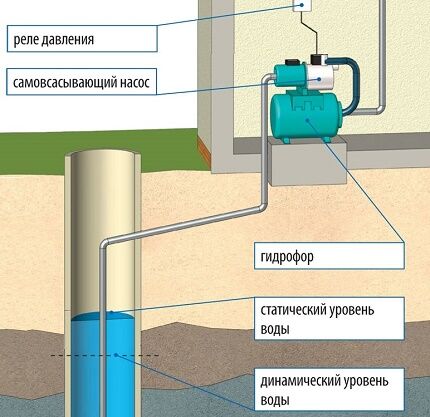
When the water stops falling, we can assume that the minimum water level in the mine has been reached. Now you need to do the operations again with the string, weight and tape measure. The measurements will give a new indicator of the well - its dynamic level.
Comparison of these data - static and dynamic levels - allows us to draw a preliminary conclusion about the productivity of the well. The smaller the difference between these indicators, the faster the water column is replenished, and the more powerful the pump can be used with such a structure.
It is worth noting that in a good artesian well, the dynamic and static level indicators may well coincide, which indicates the exceptionally high productivity of such a structure. This happens because the water arrives as quickly as it is pumped out.
The difference in levels for a high-productivity well usually does not exceed one meter. Information about the dynamic level will be useful when installing the submersible pump selected for the well. The depth of its immersion must be two meters higher than the dynamic level so that the device is always in the water.
The flow rate of a well is the amount of water that can be obtained from it within a unit of time. It is measured in the following units: l/min, cubic meters. m/hour, cubic m/day, etc. If, when pumping water with a high-power pump, the change in water level is insignificant, it means that the water is arriving quickly.
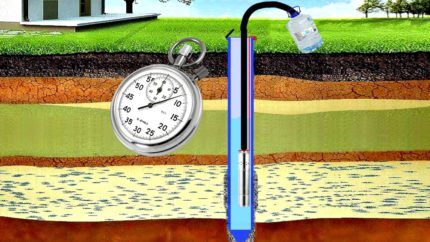
You can assume that the well's flow rate is large and choose a pump with high performance for it.When calculating the well's flow rate, it should be remembered that this is not a constant value. In spring, water flows into the well faster than in summer, and in winter this process occurs more slowly.
To understand that the well has filled with water and the inflow has stopped, you just need to measure the depth of the water level. If it coincides with the previously obtained static level, it means the well is full. Those. After pumping out the water, such measurements will have to be performed several times.

If the water decreases quickly and arrives slowly, you will need to establish the exact volumes of water that can be obtained from this well. It is necessary to take a container of significant and at the same time known volume. Most often they use a barrel, but it can be some kind of tank, bathtub, etc. The main thing is to know the volume of liquid that fits in this container.
First you need to lower the pump closer to the bottom of the well and completely pump out the water from it. This will be indicated by the characteristic “sobping” sound of a running pump.
Then they record the time and wait until the static level in the well is restored. After this, the water is pumped out again, measuring its volume. By simply dividing cubic meters by hours or liters by minutes, you can determine the flow rate of your well.
This indicator will allow you to select a pump whose performance will correspond to the volume of water arriving in the well. If the equipment is too powerful, the well will empty, which can lead to the pump running dry, i.e. without water. And this leads to quick damage to the equipment.
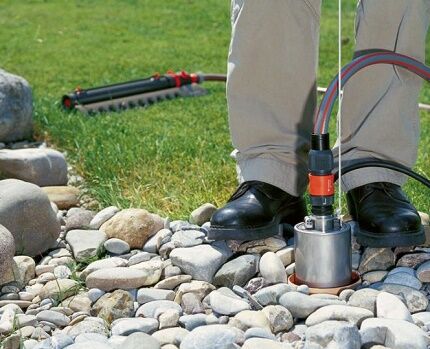
To determine the elevation of the bottom of the well, i.e. its depths, they again use twine with a heavy load without cavities inside. Now it is lowered to the very bottom until the string weakens. After this, it is taken out and measured.
Usually only the wet part of the string is measured. Its dry part corresponds to the statistical water level in the well. The total depth of the well is equal to the sum of two values: the static level and the depth to the water surface.
The diameter of a well is the diameter of its casing. To select a submersible pump, you should take into account the internal diameter, since the dimensions of the pump should allow you to freely lower it down and, if necessary, pull it back out.
Analysis of small nuances
The quality of drilling work is another point that needs to be taken into account when choosing a pump for a well. If drilling is carried out using professional equipment and a specialized team, such a well is considered more reliable.
If the drilling was carried out by shabatniks or the owners of the site with the help of amateur friends, the quality of the well is unlikely to be ideal.
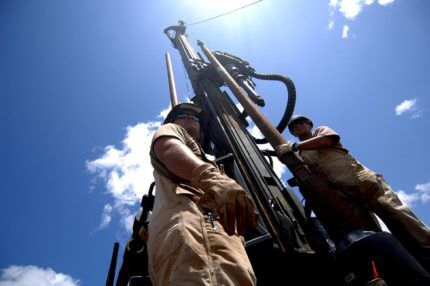
“Amateur” wells, as practice has shown, are more susceptible to the processes of filling and sanding. Therefore, for such wells it is recommended to use special pumps designed to operate in difficult conditions. Equipment of this type is more expensive.
But it better withstands situations where they receive water with a large amount of contaminants. Under the same loads, conventional pumps break down much more often. Owners of “professional” wells have more options when choosing equipment, since they can choose either a universal or a special pump.
It is not always convenient to use a rubber hose to lift water from the depth of a well to a height. During operation of the pumping equipment, the air inside the hose becomes rare, causing the walls of the hose to collapse and the flow of water stops. It is simple to prevent this phenomenon: instead of a rubber hose, you should use plastic structures of a suitable diameter.
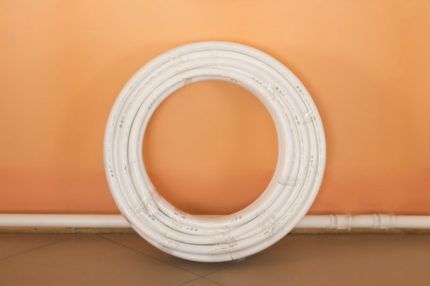
An important indicator when choosing a pump is the approximate water consumption for one day. This is an average value, since water consumption usually increases in summer, and, on the contrary, decreases in winter. It is believed that the daily consumption rate for a family of three to four people is approximately 60-70 liters.
These figures do not take into account water consumption for irrigation and other household needs. The daily rate should be increased depending on the number of plants on the site, the presence of pets, etc.
Prudent owners most often choose four-inch casing pipes for a well, although structures with a diameter of three inches are also used in this capacity. The fact is that a significant part of the pumping equipment is designed specifically for a more spacious four-inch pipe.
To convert centimeters to inches, you should divide the measurement result with a tape measure by 2.54, since this is the number of centimeters that equals one inch.
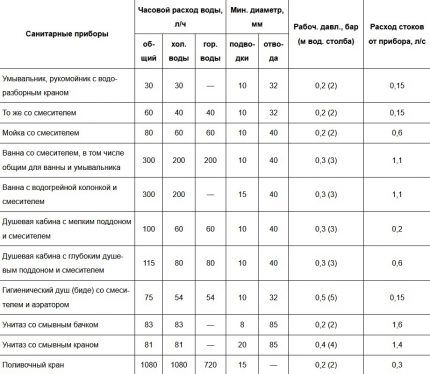
Differences between surface and submersible units
All household pumps at the place of installation are divided into two types: submersible and surface. The first ones are lowered down almost to the very bottom of the well. The second ones work on the surface. They are usually installed next to a water source or directly on the surface of the water using a special float.
The operation of surface models uses the principle of suction. The efficiency of such a pump is significantly affected by the distance over which the water has to be raised. They are usually used only if the depth to the water table is eight meters or less.
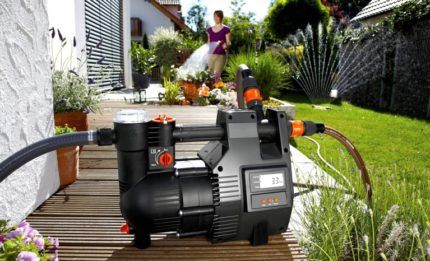
If we are talking about an Abyssinian well, of course, a surface pump will be just the ideal choice, since we are talking about a very specific well - narrow and shallow.
But when operating a filtration or artesian well, a surface pump may simply not cope with the load. In this case, you will have to choose a submersible model.
Choosing between submersible and surface pump, one should take into account the much higher noise level when operating the latter.To eliminate this nuisance, just cover the pump with a wooden box or install it in a separate room.
While surface pumps draw in water, submersible pumps push it up. When choosing such a pump, the first thing to consider is the height to which water will have to be supplied, or rather, the distance from the surface to the pump.
Therefore, a couple more meters should be added to the data on the dynamic water level. The limit height is considered to be 40 meters. If the data exceeds this figure, you will have to select a pump with increased power. The technical data sheet of each product indicates the maximum height to which it can supply water.
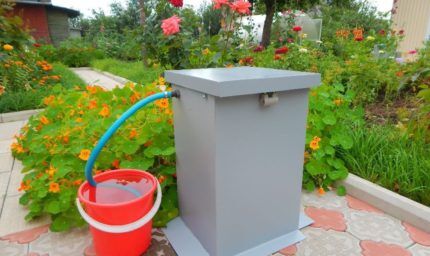
Visually, high- and low-power pumping technology differs significantly. More productive submersible pumps They have a large body and weigh significantly more than models that can cope with diving depths of up to 40 meters.
Focusing on the depth of immersion, it is better to give preference to units with some performance reserve. If the pump is designed to operate at a depth of 60 meters, it will be more suitable for a 50-meter well.
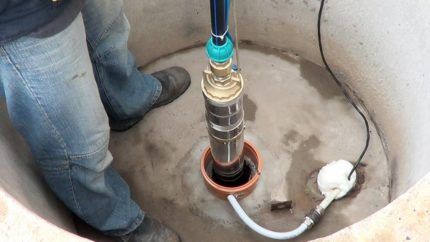
If it is lowered to the maximum depth, the unit will have to constantly work at maximum load, which will increase its wear rate and shorten its service life. For a well with a immersion depth of 60 meters, it is better to take a pump designed to operate at a depth of 70 meters. The presence of automatic protection against “dry running” is an important point when choosing a pump.
For a variety of reasons, water may stop flowing to the device. If the pump continues to operate, it may overheat, break, burn, etc. If there is appropriate automation, the device will be disconnected from power as soon as it starts idling, which will prevent the occurrence of malfunctions.
Specifics of submersible pumping equipment
Based on the type of device, a distinction is made between centrifugal and vibration pumps. In the first, a rotating disk with blades is used to supply water, in the second, a special membrane that transfers water through numerous vibrations. These design features are important because they have different impacts on well integrity.
Vibration pump + well: yes or no?
Is it possible to install a vibration pump in a well? These models are relatively inexpensive, easy to operate and have a performance that is suitable for a significant number of wells.
Many experts are categorically against the use of any vibration technology in a well shaft. However, reviews from owners report that pumps of this type are quite successfully used without any damage to the structure. So, which pump - vibrating or centrifugal - is better for a well?
The objections of experts are well founded. Prolonged vibration exposure almost always negatively affects the condition of surrounding objects. The well is no exception.
Vibrations from the pump located next to the filter affect the condition of the casing and surrounding soil, which are gradually destroyed. Vibration can cause a significant acceleration of silting and sanding processes.
But this does not happen right away. Typically, wells successfully resist vibration for some time. Therefore, with the help of such a pump it is possible to pump the well, clean it, and successfully operate it without visible damage.
But destruction from vibration still occurs, although not too quickly. Continuous use of a vibration pump can significantly reduce the service life of the structure.
If necessary, the use of vibration models is quite acceptable, but only as a temporary option.But at the first opportunity, such a pump should be replaced with a safer centrifugal device.
Guidelines for choosing a centrifugal pump
To do this, you need to carefully study the technical data sheet centrifugal device and find out a few important points:
- what is the pump performance;
- are its dimensions suitable for the well;
- from what depth can it raise water;
- what are the features of its installation and operation;
- how and under what conditions warranty service is provided, etc.
Usually consultants give quite professional recommendations when choosing such equipment. It should be remembered that many manufacturers indicate maximum, rather than average, characteristics for pumps, so you need to take into account a certain reserve of operating life.
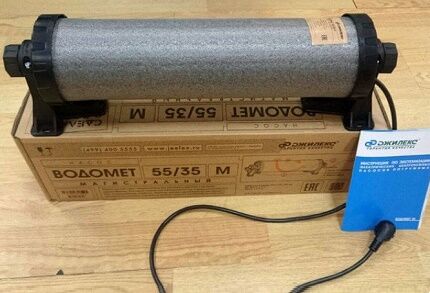
A few words about popular models
If the decision is made to use a vibration pump, it will most likely be purchased “Baby" or "Brook" These models are distinguished by good performance, resistance to breakdowns and quite affordable prices.
They are easy to clean or repair yourself. But vibration technology is not suitable for continuous use; it must be replaced as soon as possible.

Among the popular brands of submersible centrifugal pumps, it is worth noting “Aquarius" And "Water cannon"They are very similar, but according to user reviews, “Aquarius” noticeably wins in quality and durability, although it is more expensive.
However, “Vodomet” also has its adherents. If you are lucky enough to purchase a well-assembled model, it will demonstrate quite decent results.
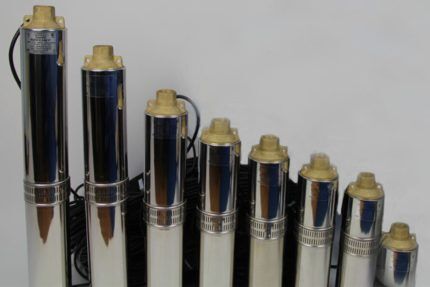
Special borehole pumps will cost a considerable amount, but such costs will be fully justified over time. As an example of such technology, it is worth noting the 3STM2 and 4STM2 models produced by TAIFU.
Conclusions and useful video on the topic
Video #1. Visual information on calculating well flow and choosing a suitable pump is contained in the following video:
Video #2. Studying the recommendations of well construction specialists before choosing a submersible pump:
Video #3. An example of calculations when selecting an Aquarius submersible pump for a water intake:
So, in order to choose a suitable pump, it is necessary to accurately study the characteristics of a particular well. You should also take into account the family’s general need for clean water and understand the operating features of different types of equipment.
Would you like to tell us about how you chose a deep-well pump for a well? Would you like to share information useful for us and site visitors? Have you found any flaws in the text? Leave comments in the block below the text of the article.




In my experience, I would recommend a suction pump. In terms of power, of course, see for yourself; the price largely depends on it.If you need water for drinking and washing, that’s one thing, but for watering you need very powerful equipment. A well is an ideal option, since the time of wells has already passed. It’s time for technology to get involved in this matter, but on the other hand there are also disadvantages: there will be no light, there will be no water, which is not very good.
There will be no light - there will be no Internet - there will be no life)) if it’s time for technology to enter, there are solar stations.
If there is no light, then no pump will work! What does suction or suction have to do with it?
When buying a pump, first of all inquire about the availability of spare parts for this equipment. This is especially true for pumps with replaceable blades. Even if you are assured that spare parts are in stock, do not be lazy to call the warehouse. You will be surprised, but in 90% of cases they will tell you that such spare parts have not been available for a long time and are not expected. A pump that has served its intended life without the ability to replace parts or components will turn into a useless piece of iron. If you buy a pump with a float sensor designed to turn off the pump to control the water level in the excavation, be sure to use it, otherwise you risk burning the pump ahead of time.
Correct me if I'm wrong about pump selection. As I understand it, it is selected based on only two parameters - pressure and performance. Productivity for a house of 3-4 people seems to me 3 m3 is more than enough. The pressure is formed from the depth to the static water level + height to the upper point of water intake and 10% of the horizontal length + 20% for losses. Then we go to almost any website of a store that sells well pumps, enter the resulting parameters into the selection filter and see pumps that suit us at different prices.Right?
legionerix, you did not take into account the well debit. If you take a pump with a higher productivity, you will simply drain the well.
These are the main indicators that people immediately focus on, but they are far from the only ones. We’ve already written to you about the well’s debit rate, but I also want to focus on such a detail as the chemical composition of the water in the well.
In fact, the pump is selected based on the chemical composition of the water. For example, for water with a high iron content, one type of pumping equipment will be suitable, while for water with a high sand content, a completely different one will be needed. This is very important because if you use the pump in an environment for which it is not intended, there is a high probability of failure.
Everything was described correctly. I prefer a vibration pump - it's inexpensive and safe. No damage to the structure.
Good afternoon. Please tell me whether it is possible to use a submersible pump with a diameter of 75 mm in a well with an internal diameter of the casing pipe of 125 mm. That is, isn't the difference in diameters too big? And is it necessary to put rubber rings on the pump to prevent the pump body from hitting the pipe walls? Or is the latter not necessary given the difference I indicated in the diameters of the pump and pipe? Thank you in advance.
The most popular cable for pumps is H07RN-F XTREM, thanks to the water resistance of the AD8 class sheath, it can supply power to electric motors and submersible pumps located at a depth of more than 100m. The possibility of use in drinking water supply systems is confirmed by the presence of an appropriate certificate.H07RN-F XTREM is a frost-resistant flexible cable with a minimum operating temperature of 40 degrees. Celsius, it is ideal for outdoor installation in the open air, and is also resistant to direct sunlight and exposure to oxygen.
Read more about the technical information and ask your questions on the website https://topovver.com/product/h07rn-f/.
There is a 15% discount for visitors using the promo code WATER2020